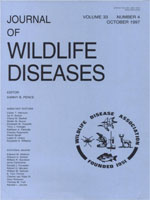Senim samples from 107 cervids were examined for Toxoplasma gondii antibodies using indirect hemagglutination (IHA), indirect immunofluorescence (IFA), enzyme linked immunosorbent assay (ELISA) and Dot-ELISA. Samples were obtained from 66 marsh deer (Blastocerus dichotomus) in the State of Sao Paulo (Brazil) and from 41 pampas deer (Ozotocerus bezoarticus) in the State of Goiás (Brazil). Antibodies to T. gondii were found in 23 (22%) of the deer, with 18 and 5 positive samples, respectively, for B. dichotomus and O. bezoarticus. The highest prevalence of T. gondii antibodies were young adults (32%), following by adults (27%) and fawns (13%). Only one serum sample (8%) from a newborn fawn was positive in the serological tests. The convenience of the Dot-ELISA test is obvious when compared with other serological tests for both laboratory or field surveys, mainly due to its features of practicability and reagent stability.
How to translate text using browser tools
1 October 1997
Toxoplasmosis in Naturally Infected Deer from Brazil
R. A. Ferreira,
J. R. Mineo,
J. M. Duarte,
D. A. O. Silva,
J. H. Patarroyo

Journal of Wildlife Diseases
Vol. 33 • No. 4
October 1997
Vol. 33 • No. 4
October 1997
antibodies
Blastocerus dichotomus
enzyme-linked immunosorbent assay (Dot-ELISA, ELISA)
haemagglutination
immunofluorescence
marsh deer
Ozotocerus bezoarticus




